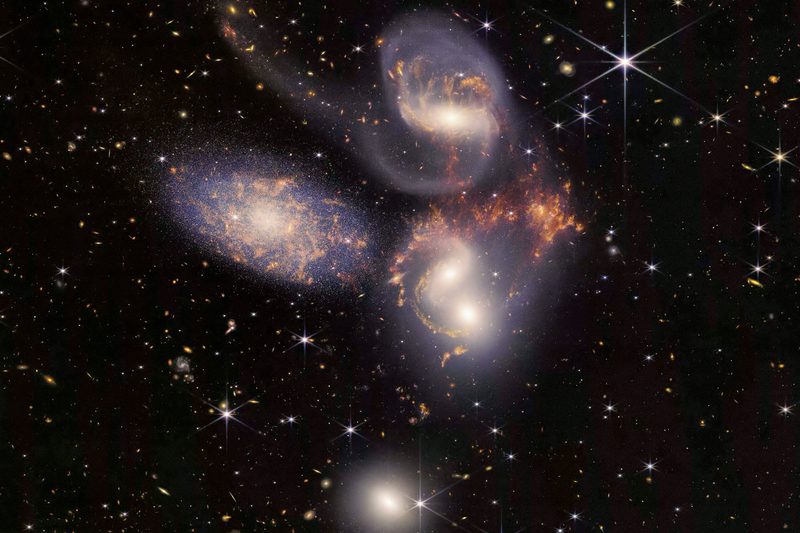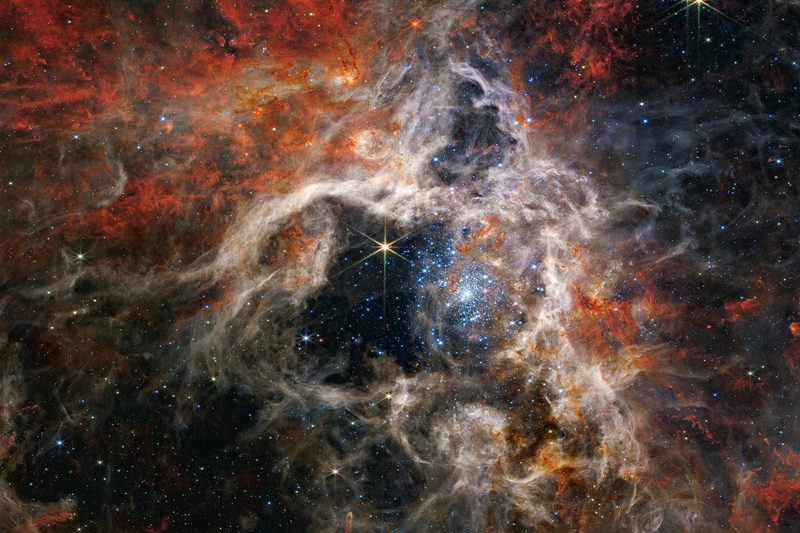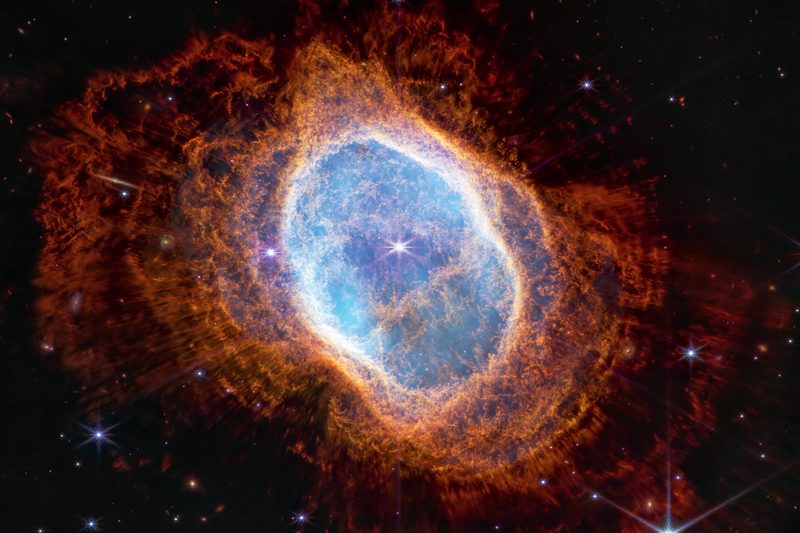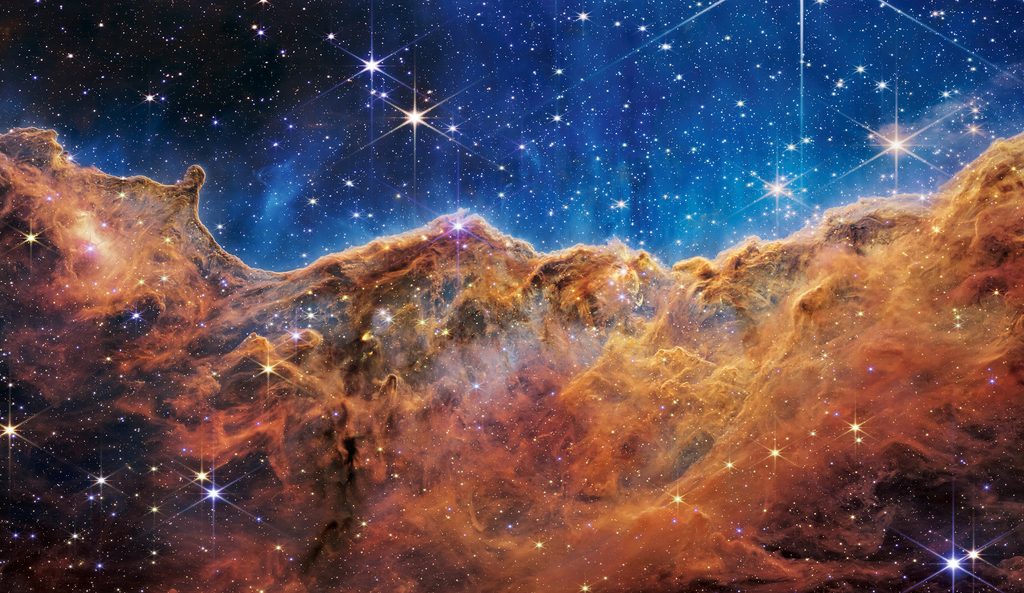Carleton’s Cindy Blaha joins fellow astronomy professor Eric Jensen ’87 in an animated discussion about the James Webb Space Telescope.

Space, still the final frontier, is indisputably of infinite fascination to most humans. Following the launch of NASA’s $10 billion James Webb Space Telescope (JWST) in December 2021, and the subsequent release of its first images in July, professional and amateur astronomers alike became exceptionally starry-eyed.
Among those closely following the project’s progress are Cindy Blaha, Carleton’s George H. and Marjorie F. Dixon Professor of Physics and Astronomy, and Eric Jensen ’87, professor of astronomy and chair of the Division of Natural Sciences and Engineering at Swarthmore College. Jensen notes that powerful telescopes can function as time machines, offering a window into distant galaxy clusters as they looked 13 billion years ago. And both Blaha and he have waited for three decades to see if the space telescope would be completed and ultimately fulfill its promise.
Early reports are that the JWST, which will be functional for at least a decade and can deliver up to 52.7 gigabytes of fresh data daily, is performing at or beyond scientists’ initial expectations, and providing professors with a treasure trove of data to inspire and inform a new generation of astrophysicists.
In December, Blaha and Jensen—who first met at a picnic held by Carleton’s Physics and Astronomy department in the spring of Jensen’s senior year, just after Blaha was hired—agreed to sit down with the Voice to share their enthusiasm for JWST, and to explain its evolution and ambitions.
How did you react when you heard the JWST was functioning as planned?
CINDY BLAHA: It was something I’d worried about for over 20 years because it is such a complicated telescope. Really, it was so exciting and such a relief—a high relief point.
ERIC JENSEN: The JWST had a long history of delays and re-budgeting [its construction began in 2004], with threatened cancellations if they didn’t get things under control. A huge amount of engineering and testing had to go into it before launch, but even once it was clear the telescope was ready to launch, there remained a number of things that had to go right the first time. I like to tinker around, but it’s pretty rare when my efforts go exactly as planned the first time; I usually have to go back and fix something. The JWST team tested a million things on the ground, but they ultimately had to launch the JWST, send it [1.5 million kilometers] into space, and trust that the mirror and heat shield would unfold correctly.

So, there was no room for error?
EJ: Not much anyway.
CB: I told my students about the launch at the beginning of our first class, last January. I was on the edge of my seat, and we cheered every time we checked to find out what had worked.
EJ: The JWST is the product of years and years of work, and it’s an enormous triumph of science, engineering, and human ingenuity. John Mather [a 1968 Swarthmore College alumnus who won the 2006 Nobel Prize for Physics] oversaw the whole project. I got the chance to talk to him a few times during the years that the telescope was being built and tested, and I was really impressed with how calm he was about the whole thing.
Are there Carleton alums who have been involved with either the early–release science teams or other specific observations that are happening now?
CB: Two Carleton class of 2011 alums, Claire Murray and David French, are both at the Space Telescope Science Institute working with the Hubble, the JWST, and other instrument science. Matt Maclay ’18 also worked there for a while, but has returned to graduate school.
What are the origins of the JWST?
CB: It started around 1996-97, when NASA was deciding what would be the next generation space telescope following the Hubble [which was launched in April 1990]. The hope was that the Hubble could overlap with the next generation telescope. The Hubble observes from ultraviolet through infrared, and the JWST observes in the red to infrared, so it can see from 0.6 microns up to 28 microns in the infrared. These are mostly wavelengths we can’t see with our eyes.
Our universe is expanding, and that expansion causes light to be redshifted. The more distant the object, the more redshift it experiences. As the light from objects gets redshifted into the infrared, the more distant objects we can see, and we see them as they were earlier in time. The very earliest galaxies have huge redshifts that shift their light from the ultraviolet into infrared. JWST is not only incredibly sensitive but it can also look at objects with redshifts from the very earliest days of structural formations in the early universe. And the JWST lets us look locally at the infrared spectra of planets around other stars.

EJ: Observing with infrared light lets us see through gas and dust better. With the JWST, we can see deeper into the big clouds of gas and dust, like those in the “pillars of creation,” a star-forming region that was one of the famous early Hubble images.
CB: Think about how the sunset is very reddened, and if there is a lot of dust in the atmosphere it gets redder. The longer the light wavelength, the easier it is to see through the dust. When we talked in class about baby star-forming regions, I’d tell the students, “We’ll have to wait for the Webb to see what’s going on at the heart of this dusty region, this nebula.”
EJ: We’re just at the start of examining the new JWST data but we’re seeing some things in the images that make you say, “Wow, that’s different than what I’ve seen before.” We had some idea of what we were going to see, but what will be cool over the next few years is our ability to focus in on things that were out of reach before, and on more distant galaxies. I’m pretty confident in saying that the most surprising and groundbreaking information is still to come. With new data from a new instrument, you have to rethink your previous simple assumptions.
Eric, you earned a PhD in astronomy in 1996 after graduating from Carleton as a physics major in 1987; Cindy, you came to Carleton in 1987 having earned a PhD in astronomy. What’s held your interest in the field over the years, and what delights you about introducing students to astronomy?
EJ: One of the things I love about teaching astronomy is that I start out the semester with a good idea of what we’ll talk about—but astronomy moves so fast that I can almost guarantee something new will have happened before the semester’s end. There is always a new insight, new things to discuss, and in some semesters that’s more common than others, but in the past year there has been new stuff every week coming out of these images and spectra. That will only accelerate with more observations.
CB: The students see the breakthroughs in the news and bring in pictures and Twitter comments, and we explore those in the context of what they’re learning. When the new JWST images rolled out, my students were researching [spiral galaxy] M33 and looking at the galaxy with a three-color image stack using light from ionized oxygen, hydrogen, and sulfur emission lines. Everyone in the computational lab was watching the JWST livestream and talking about it, and my students could explain image stacking and how the JWST images were now stacked images from the infrared observations of the telescope. It was so exciting.
EJ: It’s really fun because in astronomy there are new discoveries all the time. That’s true in some other fields as well, but the great combination of new discoveries and accessibility even for people without a huge amount of scientific background makes it different. My students and I have helped to discover new exoplanets [planets outside the solar system], for instance, and that’s tremendously fun to be a part of.

CB: Hypothetical black holes have been imaged and studied in great detail, and now we have data at multi-wavelength views showing us what those black holes are doing and how they are affecting our gravitational space-time continuum. People are naturally curious about what’s going on in the universe. I get stopped in the grocery store all the time with questions about black holes, or the JWST, or the meaning of the latest Hubble image.
EJ: People notice what’s in the news and are eager to understand more about it. I like talking to the community and students because it’s fun to be able to give people a little more context, to maybe offer a clearer explanation of a specific discovery and help people fit it together with what we knew before.
CB: It’s definitely a perk of this job—the new insights that come with every discovery, providing a whole host of new questions to ask, pursue, and make connections with. We get to link the different parts of the universe.
EJ: The physical principles haven’t changed, but what changes is what we can do with them and what we continue learning about the universe through tools like the JWST.
What do you expect the JWST will ultimately teach us?
EJ: We’re going to learn more about planets around other stars. We’re not going to discover life on other planets with the JWST—though never say never—but we will learn a lot more about the frequency of habitable planets, what’s out there that might be more like earth, which tells us more about how likely it is that there’s other life in the universe. The human connection, the sense of wonder; it’s not about building a better toaster but about the beauty of it, about the desire to learn more about the universe.
CB: I agree with Eric. In terms of the toaster idea, when I look back and consider all that was made possible by the space program, the engineering that went into making all these things work in space, I know there will be trickle-down effects. This [the JWST] was an awe-inspiring engineering feat. The sense of wonder that results from new insights can give us a great perspective on our little planet, and the fragility and uniqueness of our planetary system.

Might the JWST show us that this Earth is all we’ve got?
EJ: Human behavior and motivations are complicated, but it would be great if it turns out to be one of the benefits of this: that people will appreciate the planet we have and want to do more to maintain and preserve it.
CB: We hope there’s hope. And if we can give our students a taste of understanding what they see in the news and read on Twitter, then we can give them a gift that will keep on giving for their lifetimes and the lifetimes of their children and their future grandchildren. Because they will be called upon to answer these questions.

Add a comment